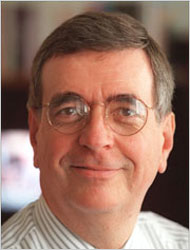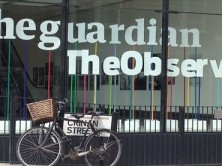
New York Times Public Editor Clark Hoyt (pictured above) writes about recent issues of conflict of interest at the newspaper. (Credit: New York Times)
The issue of conflicting interest has already been plaguing the New York Times this year. But that was before Clark Hoyt, the New York Times Public Editor reported that the Times has had to publish five editor’s notes over the last two months (two just last week) apologizing for an undisclosed interest.
Whether the conflict is the source’s or the reporter’s, disclosure is a key step toward maintaining credibility. But as StinkyJournalism has written before, disclosure is not a cure for conflicts of interest or competing loyalties. A journalist should weigh the necessity and benefit of featuring a source with a competing loyalty or conflict. If their comment is necessary for the story, the conflict should be disclosed, and their comments contextualized.
If reporters themselves work on a story where they have competing interests or loyalties, they should consider recusing themselves, ethics expert Bob Steele explained to iMediaEthics in a previous post. And, at the very least, they should disclose their relationship to the topic.
Hoyt brings up several examples of missteps in the Times’ disclosure responsibility to which they’ve had to respond in the last two months. The newspaper interviewed Michael Chertoff about airport security and full-body scanners in December, but failed to mention Chertoff is a consultant to a company that makes full-body scanning equipment. In this case, Hoyt writes, the reporters didn’t even ask the former U.S. Secretary of Homeland Security if he had any conflicts. “Chertoff did not volunteer that he is a consultant to a company that makes such equipment, and though they spoke to him twice, reporters never asked if he had a financial stake in the matter.”
Even asking isn’t always enough. For a recent story on motorized skin care devices quoting Neil Sadick, a famed Manhattan dermatologist, Hoyt says Times freelancer Camille Sweeney did ask the doctor if he had any financial conflicts. According to Hoyt, a “misunderstanding” resulted after Sadick said he did not. “After the article was published, a Times editor recalled seeing an endorsement by Sadick for a hair removal product by one of the manufacturers, Hoyt writes.
According to Hoyt, the Times also recently issued an editor’s note on Times columnist Peter Galbraith. Galbraith wrote several columns in 2005 and 2006 supporting a “strong and independent Kurdistan,” and did not disclose his ties to a Norwegian oil company operating in Kurdistan, which “positioned him to earn millions,” Hoyt writes.
The Times–like many other media groups–has policies both on how reporters should deal with the conflicts of their sources, and how they should disclose their own relationships, financial and otherwise. Recently, questions about whether the newspaper holds some of its employees to different standards regarding their conflicts came up at the NYTPicker blog over columnist David Pogue.
Hoyt says the Times standards editor sent journalists a memo “urging them to be ‘constantly alert’ to the outside interests of expert sources,” after this recent string of editors notes. It seems though that some work on the Times’ policy on reporters outside interests might also be merited.
Read Hoyt’s discussion in full here.






Comments Terms and Conditions